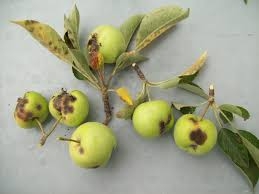Scab- Spots On Apples and Pears
Spring is here and this year (like last year) that means wet and (relatively) warm weather so we can expect this season to be another spotty one for cultivars less resistant to the fungal disease, scab. Apple and pear varieties are the most popular fruit trees in our clients' home orchards so we see a lot of apple and pear scab in our time out in the field.
Scab (Venturia spp.) overwinters on dead leaves and fruit laying on the soil surface. In spring when temperatures increase, sooty black fungal patches on the dead tissue produce primary spores, called ascospores, which release into the air or splashing water droplets then infect young buds, leaves and fruit. One to two weeks later, secondary spores called conidia are released, causing new infections and renewing the cycle.
Infections spread fastest when temperatures are between 55 and 75 F and when leaves remain wet for at least 9 hours.
Because scab thrives in a consistently wet environment, seasonal pruning can help abate infection by increasing air flow and light in the canopy of trees.
Ideally in fall, leaves from trees infected with apple or pear scab would be completely removed from the area and entirely composted or else mowed in place and dusted with agricultural lime to ensure complete decomposition leading up to the spring season.
Whether the aforementioned cultural methods have been completed or not, it would be sound practice to apply a spring holistic spray to previously infected or susceptible trees in the months of April and May.
Neem oil and the biofungicide Bacillus subtilis are the anti-fungal components of the holistic spring mix we make which addresses scab and other fruit tree diseases. While both these ingredients are safe for pollinators in the dilution rate we use, it is still important to spray when temperatures are cooler when pollinators and beneficial insects are inactive.
To avoid harming pollinators, beneficial insects, trees and ourselves we limit the use of sulfur sprays to only the most severe cases of scab infection.
The European pear cultivars Arganche, Barnett Perry, Batjarka, Brandy, Erabasma, Harrow Delight, Muscat, Orcas, and Passe Crassane are most resistant to scab.
Asian pear cultivars are less susceptible to scab infection.
The apple cultivars Akane, Chehalis, Liberty, Prima and Tydeman Red are most resistant. The varieties Jonagold, Macoun, Melrose, Spartan and King are moderately resistant to the disease.



